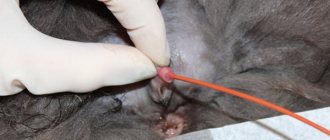Even the most responsible and caring pet owners have pets that get sick. And cats are no exception. To make an accurate diagnosis, you need to take the purring patient to the veterinarian. The specialist will give recommendations on the treatment of the cat and, if it requires injections, the animal will need to be brought to the clinic daily throughout the course of treatment (7-14 days). But such trips can be inconvenient for the owner of a four-legged pet, and for the animal it is real stress. That is why it is good if a person knows how to inject a cat without the help of others. Read on for more details on this veterinary procedure.
About injections
Quite often, cats are treated with injectable medications. Their doses are prescribed in milliliters (aka cubes). An injection means the introduction of a liquid product into the pet’s body by piercing the skin with a syringe needle (the veterinarian specifies the part of the animal’s body for injection).
It is important to remember the restrictions on the amount of drug that can be administered (daily dose) . It is connected not so much with the amount of medicine, but with its properties (exceeding the volume can lead to tissue irritation, swelling, and more serious consequences). But the injection itself will be effective and will not harm the animal if you know how to inject a cat according to all the rules.
General rules for administering injections
There are several general recommendations that need to be followed:
- if it is necessary to give injections daily, the procedure should be carried out at the same hours;
- if the animal has an appetite, you can give a treat before the injection;
- animals sense the mood of the owner, you must not panic or fuss;
- the procedure will require an assistant who will hold the cat;
- the drug is drawn up before the animal is attracted, the needle is capped;
- Before administering the injection, the area is disinfected with an alcohol solution.
The veterinarian prescribing treatment will explain in detail the rules of administration, which will help avoid mistakes, ensure the effectiveness of treatment, and give advice on choosing a syringe for the drug. For the most part, injections in cats are given with an instrument designed for insulin. Syringes can have a soldered or removable needle. If the drug is based on oil or glycerin, it is better to choose syringes with removable needles. For a liquid product, a single-piece instrument is suitable, into which you can pump the drug directly from the bottle. If the cat is large and has large fat layers, you will need syringes with long needles.
How to give an injection to a cat?
If you learn on your own how to inject a cat subcutaneously and intramuscularly, you will be able to:
- not be tied to the schedule of the veterinary clinic;
- save personal time and money;
- save your pet’s nerves;
- improve his health and save his life in an unforeseen situation.
This skill will definitely come in handy. The main thing is to know how to give a cat an injection intramuscularly or under the skin correctly: adhere to sterile conditions and precise doses of the medicine, choose the right syringe and determine the injection site for the prescribed drug.
Injections to the cat are possible intramuscularly (they are given in the hip area) and under the skin (in the withers area).
Vaccination schedule for cats
There is a generally accepted approximate vaccination schedule for cats and small kittens. In some cases, for a number of reasons, it is possible to deviate from the regimen and prescribe an individual set of vaccines.
| Name of the disease | First vaccine | Repeated vaccination |
| Calcivirosis | Between 8 and 12 weeks | A month later |
| Panleukopenia | At 8-12 weeks (simultaneous administration of vaccines is possible) | A month later |
| Rhinotracheitis | At 8-12 weeks (simultaneous administration of vaccines is possible) | A month later |
| Chlamydia | At 8-12 weeks (simultaneous administration of vaccines is possible) | A month later |
| Infectious type peritonitis | From 16 weeks | After 20 weeks |
| Trichophytosis and microsporia | From 8 weeks | After 10 weeks |
The timing of vaccinations may vary slightly depending on the cat’s health and the drug chosen. An individual vaccination schedule is selected only by an experienced veterinarian.
Medicine set
As already mentioned, it is extremely important to maintain the correct dosage of the drug . It is enough to understand the divisions on the surface of the syringe, which will allow you to administer exactly as much medicine to your pet as needed. Carefully examine the marks on the syringe in advance. If you bought an insulin syringe, it only holds 1 milliliter of liquid; others, ordinary, from 2 ml and above.
Next, wash your hands with soap and make sure the syringe is sterile. Now you can start drawing the medicine into the syringe. It is important to keep the needle sterile with each subsequent insertion. Do not touch the needle with your hands. Do not use medicinal products from ampoules where the name is erased or the expiration date is not indicated.
It is not advisable to take medicine from previously opened ampoules. If the drug is expensive, then when opening the ampoule, it is taken in the required dosage into different syringes and left in the refrigerator until use (but, one way or another, up to three days). Before injecting your cat intramuscularly, the syringe with this medicine must be warmed up in your hands.
If the product was sold in powder form (it should be diluted immediately before injection), then it cannot be stored after dilution even for a day. The remaining part must be thrown away so as not to jeopardize the health of the purr.
To avoid mistakes in the preparation and safety of the medicine, carefully study the instructions for the medicine or ask the veterinarian who prescribed it. Avoid expired medications! They not only stop working, but can also become toxic, which directly threatens the life of the animal.
After purchasing the medicine, be sure to follow the rules for storing the medicine so that it does not lose its potency and can help your four-legged friend.
Many ampoules with medicine, according to the instructions, need to be shaken before opening. After this simple manipulation, open the ampoule using a file intended for this, wrap the vessel with a cotton pad and break off the top (you need to press in the direction strictly away from you). Almost all modern products are sold in ampoules equipped with an indicator line or a special ring, which makes opening easier and eliminates the risk of injury. Once opened, carefully insert the needle into the ampoule and slowly draw out exactly as many doses as prescribed by your doctor. If the ampoule is small and the neck is narrow (less than 2 mm in diameter), when taking the medicine, you can turn it over, and at the end, squeeze out any air bubbles or excess medicine that have gotten inside the syringe.
Do not mix medications in the same syringe (as a result, a sediment may form or a chemical reaction may occur, which could result in serious harm to the animal). If you decide to give your cat an intramuscular injection and, while collecting the liquid, you see that it has changed color or consistency (and the instructions on this matter are silent), then this medication cannot be used.
Possible side effects from using antibiotics
Antibiotics, just like any other medicine, can cause side effects. Dysbacteriosis is the most common of them. Since during treatment, along with the infection, part of the natural microflora of the animal’s body is destroyed, as a result, the pet may experience disruption of the gastrointestinal tract, which can result in diarrhea. To save your cat from this, after using antibiotics, you should give her prebiotics, which will restore the body's microflora.
The composition of any medicine always contains emulsifiers, stabilizers and preservatives. Some of them can contribute to the formation of allergic reactions in the cat, such as constant subcutaneous itching and rashes.
Note! Any antibiotic may cause your cat to become lethargic and sleep more than usual.
Depending on the type of drug, its dosage and duration of use, your pet may experience other side effects: swelling, vomiting, difficulty breathing and convulsions. If an animal suffers from a disease of the urinary system, then with the use of certain types of drugs this disease may worsen. Therefore, when prescribing antibiotics, it is necessary to take into account all possible side effects.
Important! After completing a course of treatment, the animal cannot mate, since antibiotics have a negative effect on reproductive function and, as a result, inferior offspring may be obtained.
About the injection site
The instructions for the drug always indicate what type of administration the drug is intended for - under the skin or inside the muscle. There are medications that are strictly prohibited from being administered into places not intended for this purpose in order to prevent tissue necrosis.
The same diphenhydramine can be administered intravenously or intramuscularly (but not under the skin), and calcium chloride exclusively intravenously.
Check that the skin at the site of the future puncture is healthy, without damage or irritation.
What is an injection?
A shot or injection is a method of introducing medications into a cat's body by piercing and injecting the drug through a needle into certain tissues. There are restrictions on the quantity (volume) of the administered medication. As a rule, this is due not only to a limitation in quantity, but also to the properties of the drug itself (tissue irritation, etc.). There are also other specific rules for giving injections, injections for cats, which you must know before you start your medical practice.
How to give an intramuscular injection to a cat?
This injection of therapeutic fluid involves immersing the needle inside the muscle tissue. The optimal places for this are the hip or shoulder area (but experts usually choose the hip).
In order for the medication to enter the four-legged friend’s body without hindrance, the animal’s muscles must be relaxed. If the pet is pinched, it needs to be petted and calmed, its thigh should be stretched, and its paw should be slightly bent. If possible, you should avoid getting the needle into the nerve trunks.
By analogy with injections, people do not need to wipe their skin with alcohol (in most households, the skin is protected by a strong antibacterial layer). The needle should be inserted into the muscle to a depth of one centimeter.
Injections for cats at home
Owners of sick cats will have to learn how to give injections themselves. The fact is that every trip to the veterinary clinic is very stressful for the animal. And it is dangerous for a sick animal to worry, as this further complicates the course of the disease. You can, of course, call a veterinary clinic employee to your home. But for many pathologies, long courses are required (from a couple of weeks to several months), and 2-3 injections must be done per day - such calls to a specialist will cost a pretty penny. In fact, giving injections to an animal is not very difficult. The main thing is to follow all safety rules and strictly follow the instructions.
One call to a veterinarian’s home to give an injection will cost 200–300 rubles; with a long course of treatment, you will have to pay more than 15,000 rubles for the services of a specialist. (taking into account that the cost of medications is not included here) - it is much more economical to learn how to give injections to a cat yourself
Benefits of injections
Many medications are available in several forms - tablets, mixtures, rectal suppositories, injection solutions. The latter variety is recommended by veterinarians due to the following advantages:
- Fast therapeutic effect. The cat will feel relief from the injections three times faster than from the tablets.
- The ability to accurately measure the dosage of the administered drug.
- High bioavailability of active substances, since the medicine immediately enters the bloodstream.
- Possibility of administering medications that are destroyed by enzymes of the gastrointestinal tract (insulin, strophanthin, benzylpenicillin, etc.).
- Possibility of treating an animal that is unconscious or has a swallowing disorder.
- There is no risk of early withdrawal of the medication due to vomiting or diarrhea.
When providing emergency assistance to a cat, when it is necessary to quickly eliminate symptoms that threaten the animal’s life, only injections are used - drugs administered in this way begin to act within 30–60 seconds
General recommendations for treatment with injections
You can give injections yourself, but you should never self-medicate unless you have special veterinary education. You should administer medications to your cat only as prescribed by a doctor, strictly following all instructions and dosages. Even the method of injection (subcutaneous, intravenous or intramuscular) should be determined by a specialist.
The second important rule when performing injections is complete sterility. The main danger of injections is the risk of infection in the wound. That is why it is imperative to wash your hands thoroughly, use disposable syringes, and keep the area where procedures are performed clean. The injection site should be treated with an antiseptic (the most common method is to wipe the skin with alcohol).
It is important to be confident in the quality and safety of the injected product. You should double-check the dosage several times using special measuring instruments (a scale on the syringe, a measuring pipette, etc.). Before putting medicine into a syringe, be sure to check its manufacturing date - you cannot administer expired medicine.
How to prepare your pet for the procedure
Cats will struggle, try to bite and scratch the offender. The danger is that the animal may begin to resist after the needle is inserted - from sudden movements it can break off and injure the patient. To prevent this, you need to hold the animal tightly.
To securely secure the cat, it is advisable to lay it on its side or press its stomach against the table. It is recommended that two people participate in the procedure (one will fix the animal, the second will stab). The person holding the cat should clasp the front paws with one hand and the hind paws with the other. You can wrap your pet in a blanket or towel, thereby tying its limbs and leaving only the area of the body “free” where the injection will be given.
If you cannot find helpers and the cat will have to give injections alone, then it is recommended to purchase a special bag-retainer. It has a hole for the head, while the paws remain hidden inside, which does not give the animal the opportunity to dodge and run away. When fixing the cat, use a zipper to open the desired place (above the withers, hip, belly, etc.) and stick it.
Using a special bag, it is easy to give examinations and injections to sick cats (later this accessory will be useful for performing hygiene procedures - cutting nails, cleaning ears, grooming, etc.)
If there are no contraindications, then to relieve anxiety in the animal before the injection and after the procedure, it is recommended to treat the cat with a small amount of his favorite treat. You cannot shout at the cat, much less spank him (even if he scratched you). Be confident, let your pet know that you are not torturing him, but caring, he must trust you.
Any cat will resist injections, show aggression, hiss, try to run away and hide - these are signs of fear, so the animal must be calmed down, and not shouted at or punished
How to select and fill a syringe
If you need to administer a drug with a volume of less than 1 ml and the medicine is not oil-based, then you should purchase an insulin syringe with a thin short needle (it is standard - suitable for both animal injections and human injections, so it is sold in all pharmacies). If the dose is more than 1 ml, or an oil preparation is used, syringes with a volume of 2–5 ml are required. For reference: in the description of injection instruments there are often cubes - this measure is identical to milliliters (that is, a two-cube syringe is designed for a maximum volume of medicine of 2 ml).
Syringes for injection are selected depending on the dose of the drug administered and the type of medicine (oily solutions, regardless of volume, are administered only with the help of thick and long needles)
The medication is drawn into a syringe according to the following instructions:
- Open the bottle of medicine without touching it with your hands (wearing rubber gloves or using a cotton swab). Some ampoules require sawing off the top with a special file (it usually comes with the drug).
- Draw the solution into the syringe, tilting the package parallel to the floor. If the medicine is taken through a puncture in the stopper, then the bottle must be turned over vertically.
- Remove any air bubbles trapped in the syringe. To do this, turn the instrument upside down vertically and tap the instrument with your fingernail. Then press the piston until all the air comes out and a stream of liquid comes out.
- After piercing the skin with a needle, begin to apply even pressure on the piston. Try not to delay, as the administration of many medications causes pain. It is also impossible to inject too quickly - this will provoke the formation of hematomas. Focus on the injection rate of 1 ml in 2-3 seconds.
- After squeezing out all the medicine, pull out the syringe along the same path as you injected.
It should be remembered that the drug cannot be taken again from an opened ampoule of medicine. After opening, medications with airtight lids can be stored in the refrigerator for several days, only if this is mentioned in the instructions. It is forbidden to use one syringe several times - after administering the medicine, throw it away and take a new tool the next time.
How to give a subcutaneous injection to a cat at the withers?
Skin covers any part of a cat's body, but the safest and most comfortable place to administer medication with a needle is at the withers (the covering between the shoulder blades in the area of the front legs). The area of the knee fold is less commonly chosen.
Particularly painful medicinal injections are best placed at the withers, because this place is less sensitive. But keep in mind: the skin of the withers is thick and dense - which is why the needle can bend during the injection. To prevent such an incident, you need to insert the needle slowly.
The basic rules for injecting a cat at the withers remain the same: do not rub the skin with alcohol, wash your hands, make sure the needle is sterile and heat the liquid with your hands to an adequate temperature. It’s easier to inject under the skin (less likely to miss) - so even a beginner can handle it.
Pull up the fold of skin on the animal's withers, insert a needle into the base of the resulting fold at an angle of 45-50 degrees (the needle should not go deeper than the subcutaneous layer). As the needle advances, you will feel resistance. When it ends, know: the tip of the needle has already entered the skin, you can press the syringe plunger to release the medicine.
Be careful not to pierce the fold of skin on the animal's withers - this is how purring owners inadvertently inject themselves or simply inject the contents of the syringe into the air, spilling past the skin.
Typically, a cat is wrapped like this:
- A towel is laid out on the table. The cat, taken by the scruff, is placed in its middle.
- While continuing to hold the cat with one hand, the other hand throws part of the towel over the cat's back and tucks it under its side. In this case, the fabric is stretched quite strongly.
- The other half of the towel should then be wrapped around the cat and only when it is tucked under the cat's body can the scruff of the neck be released. If the cat does stick its paws out from under the towel, then it will need to be pulled tighter.
If you find an error, please select a piece of text and press Ctrl+Enter.
About the speed of drug administration
Quite often, those pet owners who already know how to give a cat an injection intramuscularly in the thigh and subcutaneously in the withers are interested in the question of how quickly the injections can be administered to the animal. Let us note that when choosing the intramuscular method, the time for introducing the medication into the animal’s body is greatly limited by the animal’s reluctance to calmly endure the unpleasant procedure, but a large volume of liquid can stratify the muscle tissue and injure the animal (after all, any injection is a microtrauma). Focus on the following calculations: for a standard-sized cat weighing 4-5 kg, a medicinal dose of more than 1 ml is considered significant.
The more medicine you inject, the slower you need to do it . On average, a dose of 1 ml must be administered in 2-3 seconds, 0.5 ml in 1 second. At the same time, it is not recommended to administer more than 1.5 ml of the drug at a time.
If you administer the medicine subcutaneously, then the speed of manipulation plays almost no role. But there are limitations in the volume of the medication: it is prohibited to administer more than 60 ml per 1 kg of body weight at the same injection point. In this regard, as a rule, large doses of medicinal liquid are injected under the skin, and small doses - inside the muscle tissue.
It happens that a cat is prescribed a large volume of saline solution. How to inject a cat in the thigh or withers in this case? Usually they give a series of injections in different parts of her body or use droppers so that she does not have to draw a whole series of syringes. At the same time, if you leave the needle at the puncture site, you can only change the syringes - this way you can avoid unnecessary injection holes.
Vaccine injection sites for cats
Vaccines (of any type) are one of the classes of injectable drugs that have been associated with the pathogenesis of Feline Injection Site Sarcoma (FISS), and particular attention has been paid to the administration of adjuvanted FeLV and rabies vaccines.
Post-injection sarcoma has been the subject of much research, and there are several new reviews on the subject (Martano et al. 2011, Srivastav et al. 2012, Ladlow 2013, Hartmann et al. 2015). Although the pathogenesis of post-injection sarcoma remains unknown, it is currently believed that a localized chronic inflammatory response leads to malignant transformation of mesenchymal cells and that this process has some genetic background.
The traditional site for most subcutaneous injections (including vaccines) in cats has been the interscapular area, where post-injection sarcoma often forms. Due to the infiltrative nature of these tumors, radical surgical resection (excision) is often necessary to remove them, although additional treatments are also used.
In North America, in recognition of this problem, it has been recommended that two adjuvanted vaccines, considered high-risk, be administered to specific anatomical sites where it will be easier to remove post-injection sarcoma if it occurs.
The “left leg leukaemia, right leg rabies” recommendation meant that FeLV vaccine should be administered in the distal left pelvic limb and rabies vaccine in the distal right leg. This recommendation is still included in the American Association of Feline Practitioners (AAFP) guidelines (Scherk et al. 2013), which also recommend that the three core feline vaccines be administered in the distal forelimb.
One study was conducted that assessed the effect of this practice by comparing the anatomical location of post-injection sarcoma in cats before the recommendation was adopted (1990-1996) and after its implementation in practice (1997-2006). The results showed that there were significantly fewer cases of post-injection sarcoma formation in the interscapular region, and more cases of tumor formation on the right (but not on the left) pelvic limb. Moreover, there has been an increase in the number of reports of tumors involving both the right hind limb and the right lateral (side) abdomen (12.5% - 25.0%) or the left hind limb and the left lateral abdomen (11.4% - 13. 8%). This has been attributed to the accidental release of drugs into these abdominal areas during inconvenient injections into the distal hind limbs. Outside of North America, this practice is not widespread.
A recent publication demonstrated the effectiveness of administering FPV and rabies vaccines to cats in the tail (Hendricks et al. 2014). Adult cats participating in the catch-and-return program received an injection of a three-part core MLV vaccine (FPV, FHV-1, FCV) into the distal third of the dorsal surface of the tail, and an inactivated rabies vaccine was administered 2 cm distal (below) the site of injection of the three-part vaccine. . Seroconversion occurred in all cats for FPV and in all but one for rabies virus. This small study reported that tail vaccination was well tolerated in cats.
In the 2010 WSAVA Vaccination Guidelines for Dogs and Cats, the VGG proposed an alternative option for administering the vaccine under the skin of the lateral chest or, better yet, the lateral abdomen (Day et al. 2010). Tail injection may be a safer alternative than distal limb or lateral body injection, but further research into this route of vaccine administration will be required. This issue remains controversial and ambiguous, and each practicing veterinarian must decide for himself which approach is convenient for use in his clinic. However, the following principles must be adhered to:
- The benefit of the protective immunity provided by vaccines outweighs any risk of developing post-injection sarcoma. Current estimates place the prevalence of post-injection sarcomas at 1 in every 5,000 to 12,500 vaccinated cats.
- Whenever possible, non-adjuvanted vaccines should be used in cats.
- Vaccines (especially adjuvanted ones) or other injectable drugs should not be administered into the interscapular area.
- Vaccines (especially adjuvanted ones) should be given subcutaneously (rather than intramuscularly) at other sites. Administration sites should be selected based on a balance between ease of surgical resection of post-injection sarcoma should it occur and an acceptable level of safety for the vaccinator (i.e., accidental self-administration of the vaccine when restraining a resistant animal must be avoided).
Vaccines should be administered at a different site each time. The injection site should be marked on a drawing in the patient’s medical history or vaccination passport, indicating there exactly which vaccines were administered in each specific case. Vaccine administration sites should be alternated. An alternative option within the clinic could be to select a single site for all staff to administer all cat vaccines during a given calendar year and change it for the following year.
The VGG encourages all suspected cases of post-injection sarcoma to be reported through the appropriate national channels for reporting suspected adverse events or to be notified directly to vaccine manufacturers.
- Translation from English. Document in English published in Journal of Small Animal Practice ¦ Vol 57 ¦ January 2021 ¦ © 2021 WSAVA
- Translation from English: S. T. Orlova, T. Yu. Malkova Edited by Doctor of Veterinary Sciences, Professor A. A. Sidorchuk December 31, 2021
Rules of behavior during an injection
If you have already figured out how to inject a cat in the thigh or withers, you can start practicing. But remember that the four-legged purr very subtly feels and notices your mood. So, your insecurity will not go unnoticed. Moreover, the animal will definitely take advantage of your condition and try to sneak away. We recommend that you have a strong attitude and try to do everything confidently, so as not to jerk at the right moment and cause unnecessary pain to your pet.
You can communicate with the animal during the injection - this will help relax it, but be alert! Your and his health depends on how securely you secure the animal so that it does not escape (sudden jerks can cause pain to you or the animal). Very temperamental animals are wrapped in a towel or blanket, and only that part of the body where the cat will be injected is left free.
Indecisive people use a pillow for training - after a couple of trials, the movements become clear and confident.
Preparing for vaccination
When the owner decides to start vaccination procedures, he must carefully prepare the cat for these manipulations in advance. All conditions are created for better functioning of the immune system and prevention of possible diseases:
- 10-12 days before the scheduled vaccination, the animal is dewormed and skin parasites are routinely treated;
- Vaccination is postponed for 10-14 days in case of any slightest ailment. If suddenly in the morning the cat does not want to eat, its behavior has changed, or any signs of illness are noted, the vaccination is canceled;
- if the cat is weakened by illness or injury, vaccination is also postponed until full recovery;
- if the animal is planning any surgical interventions, you need to ensure that the vaccination is administered 3 weeks before or after the operation;
- It is advisable to avoid the procedure when kittens change teeth and until they reach the age of 8 months;
- We compulsorily vaccinate small kittens during an outbreak of the disease, but the earliest date is limited to 6 weeks;
- After vaccination, the cat may be drowsy, lethargic, and refuse to eat for 1-2 days. If this condition persists longer, you should consult a veterinarian;
- It is necessary to monitor the cat's health status. Nutrition during the period after vaccination should be more high-calorie, nutritious and easily digestible;
- It is advisable, if possible, to vaccinate at home. This will reduce the stress level for the cat and make it easier to bear the consequences of the procedure.
Now it is possible to invite a veterinarian to your home to give all the necessary vaccinations without transporting the cat. The specialist will be able to take care of the safety of the vaccine, administer it correctly and provide recommendations for further monitoring.
Possible consequences of injections
The cat began to limp
You need to understand that even if you know how to inject a cat intramuscularly, even with all the care, the animal may limp a little after the procedure. This is the norm. Therefore, do not worry, the unpleasant consequence will pass without a trace. It’s worse if the pet drags its paw and it hangs limply. This means that you have hit the end of a needle into a nerve bundle, and such a problem requires seeking advice from a veterinary clinic. The specialist will prescribe a course of novocaine that can help.
The injection site bleeds
Wherever you inject your cat: into the thigh muscle or under the skin, as a result of the puncture the integrity of the blood vessels is disrupted and blood may flow. This is also the norm. But if it does not stop even after 5 minutes from the moment the skin is punctured, the cat is given cold for 15-20 minutes to stop the bleeding. Didn't it stop? Contact your veterinarian.
From our article you learned how to inject a cat in the withers and muscles, what types of injections exist, how to correctly take the drug and store it. You have become familiar with possible complications and how to prevent or eliminate them. All this information is aimed at helping you maintain the health and life of your pet. Take care of your pets!
Safety precautions
You should not make the mistake of thinking that if a cat is very calm and docile in its normal state, then it will be just as calm when it is sick or in severe pain. The same can be said about taking especially nasty-tasting pills that can unbalance even a very calm animal. You should never put yourself at unnecessary risk by giving your pet medication without trying to hold it back. It's even worse when the cat is approached face-first without any restraint. We should not forget that cat bites and scratches are quite painful and can cause serious illness. Because of this, being safe is much better than being careless. If a cat scratches or bites its owner, then he should definitely consult a doctor.
Why learn to give injections?
The skill of giving injections yourself allows you to be independent, saves time and money, and can save the life of your furry pet in an emergency. In addition, you can make money from this by helping others.
The first rule is sterility, correct injection site and clear doses!!!!!!!!!!!!!!!!!!!
You must clearly understand what you want to inject into your cat, where and how much.
In doctor's recommendations you can find the following abbreviations:
- IM means intramuscularly, usually into the thigh;
- s/c - meaning subcutaneously, usually at the withers.










